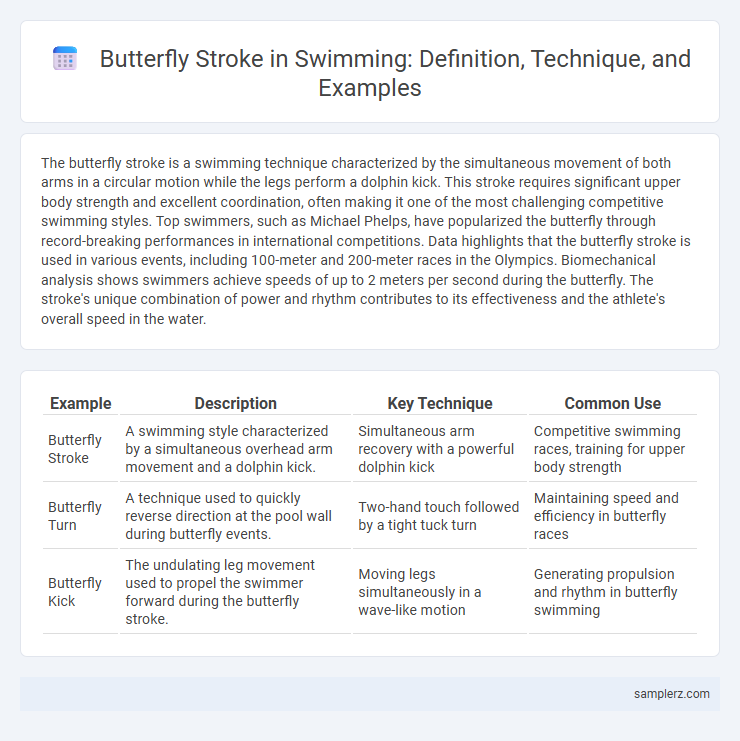The butterfly stroke is a swimming technique characterized by the simultaneous movement of both arms in a circular motion while the legs perform a dolphin kick. This stroke requires significant upper body strength and excellent coordination, often making it one of the most challenging competitive swimming styles. Top swimmers, such as Michael Phelps, have popularized the butterfly through record-breaking performances in international competitions. Data highlights that the butterfly stroke is used in various events, including 100-meter and 200-meter races in the Olympics. Biomechanical analysis shows swimmers achieve speeds of up to 2 meters per second during the butterfly. The stroke's unique combination of power and rhythm contributes to its effectiveness and the athlete's overall speed in the water.
Table of Comparison
| Example | Description | Key Technique | Common Use |
|---|---|---|---|
| Butterfly Stroke | A swimming style characterized by a simultaneous overhead arm movement and a dolphin kick. | Simultaneous arm recovery with a powerful dolphin kick | Competitive swimming races, training for upper body strength |
| Butterfly Turn | A technique used to quickly reverse direction at the pool wall during butterfly events. | Two-hand touch followed by a tight tuck turn | Maintaining speed and efficiency in butterfly races |
| Butterfly Kick | The undulating leg movement used to propel the swimmer forward during the butterfly stroke. | Moving legs simultaneously in a wave-like motion | Generating propulsion and rhythm in butterfly swimming |
Understanding the Butterfly Stroke in Competitive Swimming
The butterfly stroke is characterized by a simultaneous arm movement paired with a powerful dolphin kick, making it one of the most physically demanding styles in competitive swimming. Swimmers optimize buoyancy and propulsion by synchronizing their arm recovery over the water with the energetic undulation of the hips and legs. Mastery of timing and breath control in the butterfly stroke enhances speed and efficiency, crucial for succeeding in events like the 100m and 200m butterfly races.
Key Techniques of the Butterfly in Swimming
Mastering the butterfly stroke requires precise coordination of the dolphin kick, simultaneous arm pulls, and rhythmic breathing techniques to maximize speed and efficiency. Key techniques include maintaining a strong core to facilitate smooth undulation, ensuring the arms enter the water shoulder-width apart, and timing the breath during the arm recovery phase. Proper execution of these elements enhances propulsion and minimizes drag, leading to improved performance in competitive swimming.
Historical Milestones of the Butterfly Stroke
The butterfly stroke emerged as a variation of the breaststroke in the 1930s, with American swimmer Henry Myers pioneering the early technique. In 1952, the International Swimming Federation (FINA) officially recognized butterfly as a distinct competitive stroke, revolutionizing competitive swimming. Mark Spitz's dominance in the 1972 Olympics showcased the stroke's speed and power, cementing its place in swimming history.
Common Mistakes When Performing Butterfly
Common mistakes when performing the butterfly stroke include incorrect arm movement, such as crossing the arms over the centerline, which disrupts the stroke's efficiency. Many swimmers also struggle with timing, failing to coordinate the dolphin kick properly with arm pulls, leading to increased drag and reduced propulsion. Another frequent error is an improper body position, where the hips drop too low, causing excessive resistance and fatigue during the swim.
Notable Butterfly Swimmers in History
Michael Phelps revolutionized butterfly swimming with his record-breaking performances, securing 22 Olympic gold medals that highlight his dominance in the stroke. Kristin Otto, a German swimmer, made history by winning multiple Olympic butterfly titles during the 1980s, setting world records in the 100m and 200m butterfly events. Dawn Fraser also left a significant mark with her powerful technique and three consecutive Olympic gold medals in the butterfly, inspiring generations of swimmers.
Effective Drills to Improve Butterfly Form
Effective butterfly drills include single-arm butterfly strokes to enhance arm coordination, dolphin kicks on a kickboard to strengthen the core and hip movement, and body dolphin exercises to improve undulation and timing. These drills target key muscle groups like the lats, shoulders, and core, promoting a more powerful and fluid stroke. Consistent practice of these techniques leads to improved stroke efficiency, reduced drag, and faster race times.
Training Programs for Butterfly Stroke Swimmers
Training programs for butterfly stroke swimmers emphasize high-intensity interval sets to build explosive power and endurance, typically involving repeated 50- to 100-meter sprints with controlled rest periods. Drills focusing on the dolphin kick and timing of the arm pull enhance stroke efficiency, while core strength exercises and flexibility routines improve overall body control and reduce injury risk. Coaches often incorporate video analysis to refine technique and monitor progress throughout the training cycle, ensuring peak performance during competition.
Butterfly Stroke Rules in Olympic Swimming
The butterfly stroke in Olympic swimming requires swimmers to keep both arms moving symmetrically and recover over the water during each cycle. Rules mandate that the swimmer's body remains on the breast, and both feet must touch the wall simultaneously during turns and at the finish. Maintaining a dolphin kick, characterized by a simultaneous, rhythmic motion of both legs, is essential for legal butterfly technique in competitive meets.
Benefits of Mastering the Butterfly Stroke
Mastering the butterfly stroke enhances cardiovascular endurance by engaging major muscle groups such as the shoulders, chest, and core in a powerful, synchronized movement. This stroke improves overall swimming efficiency and speed due to its unique undulating technique that maximizes propulsion. Strengthening these muscle groups also aids in injury prevention and promotes better coordination and breathing control in competitive swimming.
Comparing Butterfly with Other Swimming Strokes
The butterfly stroke, known for its simultaneous arm movement and powerful dolphin kick, generates greater propulsion compared to freestyle, backstroke, and breaststroke, enabling faster sprint speeds. Unlike the alternating arm motion in freestyle and backstroke or the frog-like kick in breaststroke, the butterfly demands higher energy expenditure and superior upper body strength. Swimmers often find the butterfly technique more challenging due to its timing and coordination, but it offers unparalleled acceleration and fluidity in competitive swimming.

example of butterfly in swimming Infographic
 samplerz.com
samplerz.com